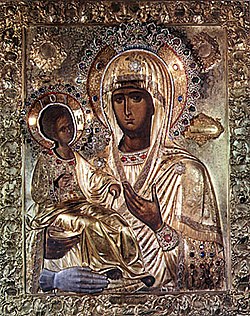Top Qs
Timeline
Chat
Perspective
July 12 (Eastern Orthodox liturgics)
Day in the Eastern Orthodox liturgical calendar From Wikipedia, the free encyclopedia
Remove ads
July 11 - Eastern Orthodox Church calendar - July 13

All fixed commemorations below are celebrated on July 25 by Old Calendar.[note 1]
For July 12th, Orthodox Churches on the Old Calendar commemorate the Saints listed on June 29.
Saints
- Saint Veronica, the woman with the issue of blood who was healed by the Savior (1st century)[1][2][3][4][5][6][note 2]
- Martyr Serapion the New, at Alexandria (194-211)[1][3][5][7] (see also: July 13)
- Martyrs Proclus and Hilary, of Ancyra (2nd century)[1][3][8][9][note 3]
- Martyrs Andrew the Commander, Heraclius, Faustus, Menas, and those with them.[3][5][11][12] (see also: August 31)
- Great-martyr Mamas, whose synaxis near Sigma we celebrate.[3][5][12][13][note 4]
- Martyr Golinduc, in holy baptism Mary, of Persia (591)[1][14][15][16] (see also: July 13)
- Venerables John (998) and Gabriel (10th century) of Georgia and Iveron, Mt. Athos.[1][5][14][17]
- Venerable Michael Maleinus, spiritual father of Saint Athanasius of Athos (962)[1][3][5][18][19]
- Martyrs Theodore of Kiev and his son John, the Varangians, at Kiev (983)[1][5][14][20]
Remove ads
Pre-Schism Western saints
- Saint Hermagoras of Aquileia, and his deacon Fortunatus, martyrs under Nero (c.66)[21][22][note 5][note 6]
- Saint Paulinus of Antioch, and Companions (c. 67)[21][23][note 7][note 8]
- Saint Marciana, a virgin-martyr venerated in Toledo in Spain (c. 303)[21][note 9]
- Saints Nabor and Felix, martyrs in Milan in Italy under Diocletian (c. 304)[5][21][24][note 10]
- Saint Paternian, Bishop of Bologna in Italy (c. 470)[10][21]
- Saint Viventiolus, a monk at St Oyend in France who became Archbishop of Lyons (524)[10][21][note 11]
- Saint Proculus, Bishop of Bologna in Italy (540-542), martyred by the Goths (542)[21]
- Saint Menulphus (Menou), born in Ireland, he became Bishop of Quimper in Brittany (7th century)[21][25][note 12]
- Saint Ansbald of Prüm, in Germany (886)[21][note 13]
Remove ads
Post-Schism Orthodox saints
- Blessed Serapion of Vladimir, Bishop of Vladimir (1275)[1][5][14]
- Saint Arsenius of Novgorod, Fool-for-Christ (1570)[1][5][12][14][26][27]
- Monk-martyr Simon (Symeon), founder of Volomsk Monastery, Vologda (1641)[1][5][14][28][note 14]
- Venerable Paisios the Athonite (1994)[12][29][30] (New Style only, Old Style date June 29, see: June 29 )
Other commemorations
- Icon of the Most Holy Theotokos "Of the Three Hands" of Hilandar, Mt. Athos.[1][12][14][31] (see also: December 4 and June 28 )
- Icon of the Most Holy Theotokos of Prodromos Skete, Mt. Athos, of Voronezh and of Jackson, California (7th century)[1]
- Translation of the relics (1620) of St. Anthony of Leokhnov, founder of Leokhnovo Monastery, Novgorod (1611)[1][14]
- Translation of the relics (2004) of New Hieromartyr Momcilo Grgurevic of Serbia (1940s)[1][14][note 15]
- Repose of Hieromonk Daniel (Fomin) of Optina and Sorochinsk (1953)[1]
Remove ads
Icon gallery
- St. Veronica with the Acheiropoieta.
- Image of the Saviour Made Without Hands (Simon Ushakov, 1658).
- St. Michael Maleinus.
- Martyr Theodore of Kiev.
- Saints Hermagoras and Fortunatus.
- Débredinoire (sarcophagus) of Saint Menoux.
- Monk-martyr Simon (Symeon) of Volomsk.
- Icon of Panagia Tricherousa ("Three-handed Theotokos").
Notes
- The notation Old Style or (OS) is sometimes used to indicate a date in the Julian Calendar (which is used by churches on the "Old Calendar").
The notation New Style or (NS), indicates a date in the Revised Julian calendar (which is used by churches on the "New Calendar"). - He may be the same saint as the martyr on September 2.
- According to tradition, St Hermagoras was a disciple of the Apostle Mark and was consecrated first Bishop of Aquileia in Italy. After a fruitful apostolate he and his deacon Fortunatus were beheaded under Nero.
- "At Aquileia, the birthday of St. Hermagoras, disciple of the blessed evangelist Mark, and first bishop of that city. Whilst occupied in performing miraculous cures, in preaching frequently and bringing souls to repentance, he suffered many kinds of torments, and finally by capital punishment, merited an immortal triumph with his deacon Fortunatus."[10]
- Venerated as the first bishop and patron-saint of Lucca in Tuscany in Italy. By tradition he was born in Antioch and sent to Lucca by the Apostle Peter where he was martyred with others.
- He was close to St Avitus of Vienne.
- See: (in French) Saint Menulphe. Wikipédia. (French Wikipedia).
- Born in Luxembourg, he became a monk at Prüm in Germany, then Abbot of Saint-Hubert in the Ardennes, and finally of Prüm in 860. His monastery was burnt down by the Vikings in 882 but he succeeded in restoring it.
- See: (in Russian) Симон Воломский. Википедии. (Russian Wikipedia).
- See: (in Serbian) Момчило Гргуревић. Википедију. (Serbian Wikipedia).
Remove ads
References
Sources
Wikiwand - on
Seamless Wikipedia browsing. On steroids.
Remove ads








